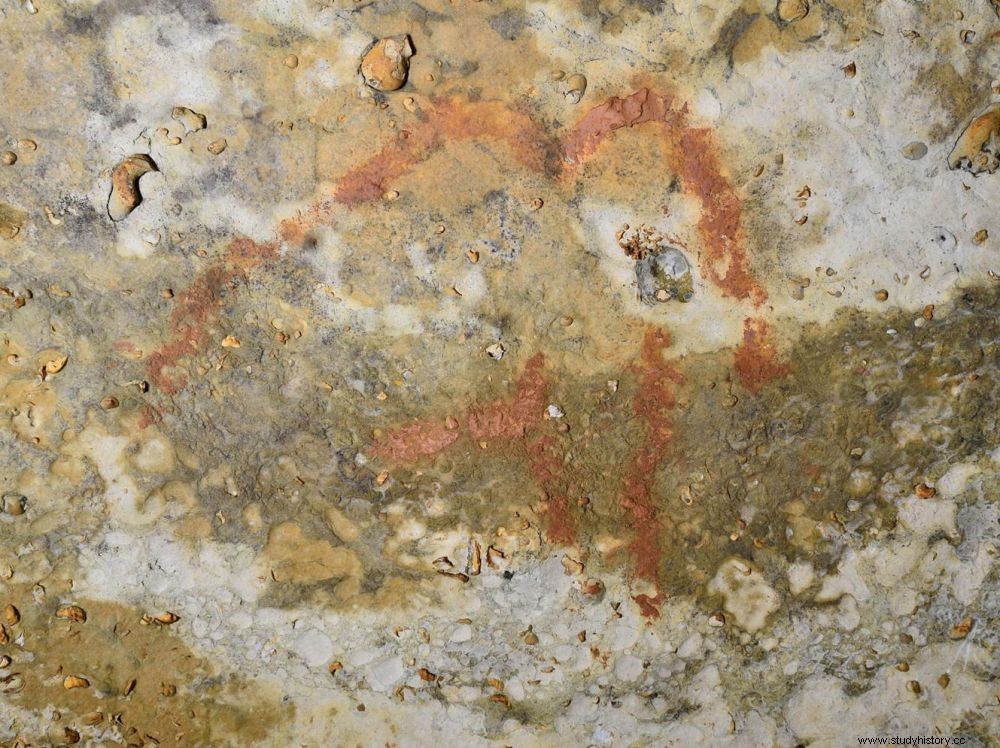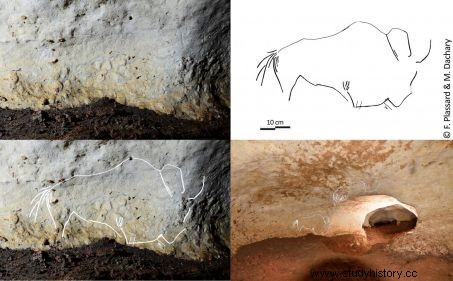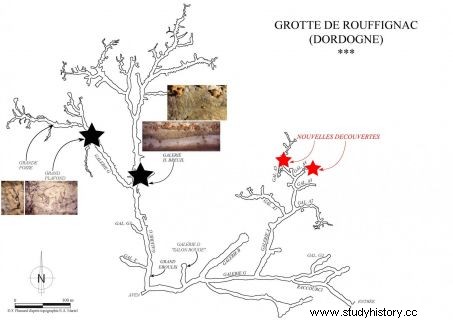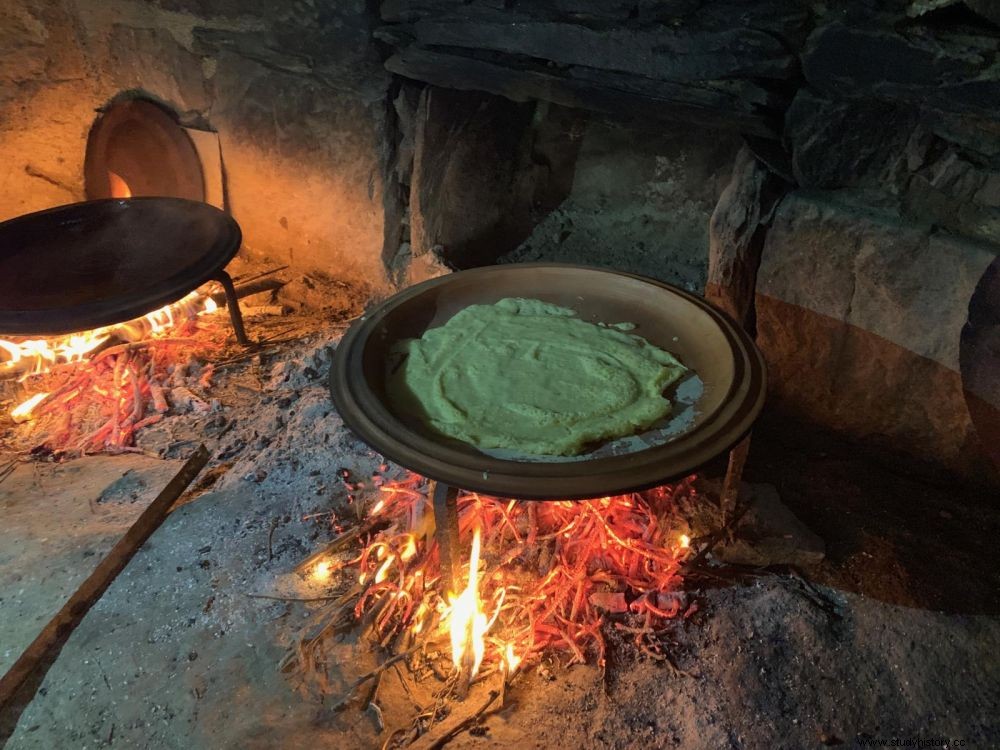No less than 13 new figures, including a potential female silhouette, were brought to light during confinement by the owner of the premises. All of these findings still need to be analyzed.

The mammoth traced with a clay mound discovered first at the end of March 2020 by Frédéric Plassard and Morgane Dachary.
Nearly four months after the end of the confinement, the experiences shared by each other continue to confirm what we already knew:we did not all experience this strange time entrenched in our homes in the same way. Frédéric Plassard, owner of the Rouffignac cave, hardly dares to say that he is one of those who will keep happy memories of it. "We have been very unequal in the face of confinement. I am aware that I have been privileged" , he confides. These long weeks, he spent them surveying the galleries of this exceptional prehistoric site, an immense cave articulated in more or less wide galleries over more than 8 km. Successively frequented by cave bears and Paleolithic hunter-gatherers, it conceals on its walls more than 250 animal figures – mostly mammoths – partly visible to the public on board a small train.
Frédéric Plassard did not exceed the rules imposed by the government on the question of leaving the home. The Rouffignac cave is located on his property, a few kilometers from his house. It was his grandfather who acquired it more than 90 years ago, without knowing that the underground mentioned on the deed of sale was a real gem of parietal art. "When he bought the land, he knew that a cave was there. It was known because it was open to the outside and was already mentioned in writings. This is not only in 1956 that we discovered its archaeological dimension." On June 26 of this year, Professor Louis-René Nougier, a prehistorian at the University of Toulouse, and Romain Robert, an enlightened amateur, fell by the light of their lamp on dozens of paintings and engravings never really identified before. Since that day, Rouffignac has been considered one of the largest decorated caves in Europe.
At the corner of an isolated gallery, an unknown mammoth
Sixty-four years later, at the end of a month of March such as the world had never known, Frédéric Plassard, guide-lecturer of this natural labyrinth but also a doctor in prehistory attached to the CNRS unit in Bordeaux, decides to use all this imposed free time to devote himself to some research work in situ . With his wife, the prehistorian Morgane Dachary, he goes to a little frequented part of the cave "to resume a study, at the request of a protohistorian, on ceramics in the second Iron Age in connection with an activity sepulchral".
Nearly four months after the end of the confinement, the experiences shared by each other continue to confirm what we already knew:we did not all experience this strange time entrenched in our homes in the same way. Frédéric Plassard, owner of the Rouffignac cave, hardly dares to say that he is one of those who will keep happy memories of it. "We have been very unequal in the face of confinement. I am aware that I have been privileged" , he confides. These long weeks, he spent them surveying the galleries of this exceptional prehistoric site, an immense cave articulated in more or less wide galleries over more than 8 km. Successively frequented by cave bears and Paleolithic hunter-gatherers, it conceals on its walls more than 250 animal figures – mostly mammoths – partly visible to the public on board a small train.
Frédéric Plassard did not exceed the rules imposed by the government on the question of leaving the home. The Rouffignac cave is located on his property, a few kilometers from his house. It was his grandfather who acquired it more than 90 years ago, without knowing that the underground mentioned on the deed of sale was a real gem of parietal art. "When he bought the land, he knew that a cave was there. It was known because it was open to the outside and was already mentioned in writings. This is not only in 1956 that we discovered its archaeological dimension." On June 26 of this year, Professor Louis-René Nougier, a prehistorian at the University of Toulouse, and Romain Robert, an enlightened amateur, fell by the light of their lamp on dozens of paintings and engravings never really identified before. Since that day, Rouffignac has been considered one of the largest decorated caves in Europe.
At the corner of an isolated gallery, an unknown mammoth
Sixty-four years later, at the end of a month of March such as the world had never known, Frédéric Plassard, guide-lecturer of this natural labyrinth but also a doctor in prehistory attached to the CNRS unit in Bordeaux, decides to use all this imposed free time to devote himself to some research work in situ . With his wife, the prehistorian Morgane Dachary, he goes to a little frequented part of the cave "to resume a study, at the request of a protohistorian, on ceramics in the second Iron Age in connection with an activity sepulchral".

A bison and a view of the gallery. Credits:Frédéric Plassard and Morgane Dachary
Plunging into a side gallery far from the main axis of circulation and with a reputation for being sparsely decorated, he spots a clay drawing evocative of a figure he knows well, that of a mammoth. He thinks first of a recent graffiti, "maybe that of a student from the 50s or 60s who wanted to make a joke" . But quickly, he notices that the clay is a little calcite, cracked, and therefore applied a long time ago. "Seeing this, I had no doubts, because the figure was perfectly acceptable and the technique known elsewhere." Excited by the find, the couple agree to come back the next day to explore this corner more carefully.

Map of the Rouffignac cave, where the location of the new discoveries is indicated in red. Credits:Frédéric Plassard and Morgane Dachary
During the following days, sometimes assisted by his son, sometimes by his father, the prehistorian Jean Plassard (prehistory is definitely a family affair), Frédéric Plassard finds no less than nine additional figures, bringing the total of his discoveries to 13 drawings. "Mammoths, a bison, a paw corresponding to an unidentified animal and a possible female figuration, the one that stirs consciences today", ventures the expert. Because if the confirmation that it is indeed a woman's silhouette were to fall in the future, the whole chronological distribution of this rare motif, which appeared late in the Paleolithic, would be disrupted. According to the current state of our knowledge, these female figures are only observed in the Upper and Final Magdalenian (13,500-12,500 BC), mostly in cramped or isolated places. Very schematic, only composed of two lines corresponding to a bust and thighs seen in profile, they are almost always represented in groups. If that of Rouffignac is indeed one, it would not only be the first in the cave, but also the first to have been represented in the Middle Magdalenian.
A female figure who questions
So when he distinguishes a strange line engraved in the rock, Frédéric Plassard does not understand what he sees. "It is a gallery that is difficult to access, in which you can only move by crawling on your stomach or on your back. It is only 60 centimeters high and 1.20 meters wide, it's very uncomfortable. Not to mention the fact that this female figure, if it exists, is superimposed on a mammoth, and therefore difficult to read." Despite everything, he conscientiously carried out his survey. It was later, in his office, that he began to wonder... and to think that it might indeed be an isolated female figure.

A bison and a view of the gallery. Credits:Frédéric Plassard and Morgane Dachary
Frédéric Plassard admits it:he has been walking on eggshells since France Bleu , followed by other major media, relayed his discovery. He has the feeling that the steps have been skipped. No document, not even a simple statement, has yet been published in a scientific journal. That is why today we do not have the photo of this female figure. "When it comes to human representation, the excitement is immediate. However, you have to be very careful, especially with such partial drawings." In addition to its very incomplete layout conducive to interpretation, two things still bother him:the uniqueness of this representation on the site of Rouffignac but also, and above all, its lonely appearance. "I know of only one cave where one of these female figures is shown alone, a cave in Spain. In almost all cases there are several of them and almost fit together. others."
Patrick Paillet, prehistorian at the National Museum of Natural History who was able to visit the scene, is rather favorable to this hypothesis. Jean Plassard, he doubts a lot. It will therefore be necessary to wait for the research, currently being written, to be published and to be the subject of debate in the scientific community. In the meantime, the Plassard family continues to marvel at their discoveries. “Rouffignac cave art is quite evident and systematic surveys have been taking place since the 1950s. We had always assumed that what should be had been seen. We are glad we were wrong. "
